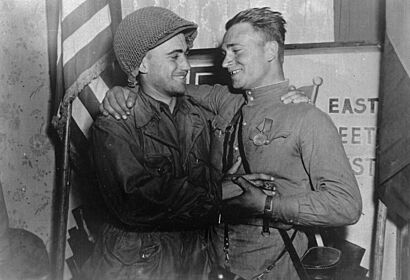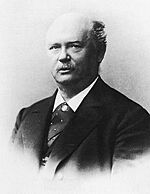Torgau facts for kids
Torgau is a town in Germany, located on the Elbe River in the state of Saxony. It's the main town of the Nordsachsen district. Torgau is famous because it was where the American and Soviet armies first met during World War II on April 25, 1945. This event is often called "Elbe Day."
Quick facts for kids
Torgau
|
||
|---|---|---|

Hartenfels Castle
|
||
|
||
| Country | Germany | |
| State | Saxony | |
| District | Nordsachsen | |
| Municipal assoc. | Torgau | |
| Elevation | 78 m (256 ft) | |
| Population
(2022-12-31)
|
||
| • Total | 19,802 | |
| Time zone | CET/CEST (UTC+1/+2) | |
| Postal codes |
04860
|
|
| Dialling codes | 03421 | |
| Vehicle registration | TDO, DZ, EB, OZ, TG, TO | |
Contents
History of Torgau
Torgau started as a Slavic village called Turguo. People believe there was a wooden castle where Hartenfels Castle is today.
In the 900s, the area became part of the Holy Roman Empire. A stone castle was built, and the town grew around it. By 1119, Torgau had a market. The town was on an important trade route called the Via Regia, which connected Leipzig and Frankfurt (Oder). This route crossed the Elbe River near Torgau.
Torgau was part of the Duchy of Saxe-Wittenberg. This area became the Electorate of Saxony in 1356. In 1423, the Wettin family took over. They made Torgau their home.
After 1485, Torgau belonged to the Ernestine branch of the Wettin family. Frederick III, Elector of Saxony and his family built Hartenfels Castle. This castle is the largest fully preserved early Renaissance castle in Germany. From 1525, Torgau became their main home.
Torgau and the Reformation
During the Protestant Reformation, Torgau played an important role. In 1523, the town council closed all monasteries. People in Torgau even removed religious paintings and statues from churches.
Katharina von Bora, the wife of Martin Luther, died in Torgau. She is buried in the Marienkirche. The court chapel at Hartenfels Castle was built in 1543-44. Martin Luther himself dedicated it on October 5, 1544. It is one of the oldest Protestant churches built for that purpose.
Important religious writings were also created in Torgau. The Torgauer Artikel, an early version of the Augsburg Confession, was written here in 1530. The Lutheran Formula of Concord was also written in Torgau in 1576.
The first German opera, Dafne by Heinrich Schütz, was performed in Torgau in 1627.
In the Battle of Torgau on November 3, 1760, the Prussian army defeated the Austrian army. This was a major battle during the Seven Years' War. After 1815, Torgau became part of Prussia.
Torgau in World War II
Torgau is famous for a special event during World War II. On April 25, 1945, the United States Army from the west met the Red Army from the east. This meeting happened on a bridge in Torgau. It also happened at Lorenzkirch, a town nearby. This day is remembered as "Elbe Day".
The commanders of both armies met the next day in Torgau. They shook hands to mark this historic moment. This meeting showed where the American and Soviet forces would meet. However, the area around Torgau, first held by U.S. forces, was later given to Soviet forces. This was part of an agreement made earlier.
After the war, in 1949, a film called Encounter at the Elbe was made about this meeting.
After World War II
After World War II, the Soviet secret police used prisons in Torgau. These were called Special Camps Nos. 8 and 10. Germans and some Soviet citizens were held there. Some had been sentenced by Soviet military courts. From 1950 to 1990, the East German police used the Fort Zinna prison. In the 1950s, it mainly held people who disagreed with the government.
Today, the Torgau Documentation and Information Center (DIZ) studies the history of these prisons. It has an exhibition called "Traces of Injustice." This center helps people understand the history of the prisons.
After World War II, Torgau was first part of Saxony Anhalt in East Germany. In 1952, it became part of the Bezirk Leipzig region. After Germany reunited in 1990, Torgau became part of the state of Saxony. Since 2008, it has been the main town of the Nordsachsen district.
Geography of Torgau
The town of Torgau includes the main town and several smaller areas. These areas are called Ortschaften, or municipal divisions.
- Beckwitz
- Graditz
- Loßwig
- Mehderitzsch
- Melpitz
- Staupitz
- Weßnig
- Zinna
Beckwitz, Loßwig, Mehderitzsch, Staupitz, and Weßnig used to be part of a different town called Pflückuff. They became part of Torgau on January 1, 2009.
Population Changes
Torgau's population has changed over the years:
|
|
|
|
- Data source from 1999: Statistical office Saxony
1 including barracks
2 Incorporation Pflückuff
Places to See in Torgau
Torgau has many interesting sights. You can visit the historic town center, which has been restored. There is also a brewery museum. A monument marks the meeting of the Russian and American troops on the Elbe. You can also visit a Russian military cemetery.
The early Renaissance Hartenfels Castle is a main landmark. Its chapel was built in 1544 and combines old Gothic styles with new Renaissance elements. Martin Luther dedicated it on October 5, 1544. You can still see Brown bears living in the castle moat!
Sister Cities
Torgau is twinned with these cities:
 Hämeenkyrö, Finland
Hämeenkyrö, Finland Sindelfingen, Germany
Sindelfingen, Germany Znojmo, Czech Republic
Znojmo, Czech Republic
Famous People from Torgau
Many notable people have connections to Torgau:
- Frederick III, Elector of Saxony (1463–1525) – A ruler who protected Martin Luther.
- Nicolaus von Amsdorf (1483–1565) – A Lutheran theologian and early Protestant reformer.
- Leonhardt Schröter (c.1532 – c.1601) – A Renaissance choirmaster and composer.
- Andreas Schato (1539–1603) – A physician, mathematician, and scientist.
- Johann Philipp, Duke of Saxe-Altenburg (1597–1639) – A duke of Saxe-Altenburg.
- Dorothea of Saxe-Altenburg (1601–1675) – A princess from the House of Wettin.
- Eduard Oscar Schmidt (1823–1886) – A zoologist.
- Georg von Siemens (1839–1901) – The founding director of Deutsche Bank.
- Leonhard Koeppe (1884–1969) – An eye doctor (ophthalmologist).
- Wolf Roth (born 1944) – An actor.
- Wolfgang Klotz (born 1951) – A gymnast.
- Olaf Marschall (born 1966) – A footballer.
- Kai Kazmirek (born 1991) – A decathlon athlete (competes in ten track and field events).
Gallery
See also
 In Spanish: Torgau para niños
In Spanish: Torgau para niños









